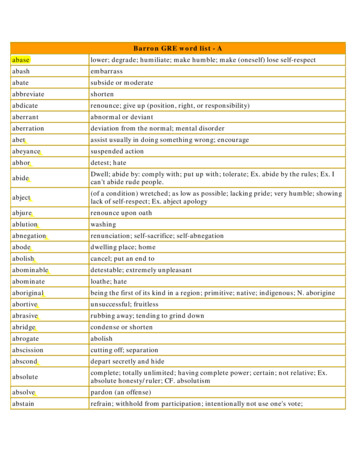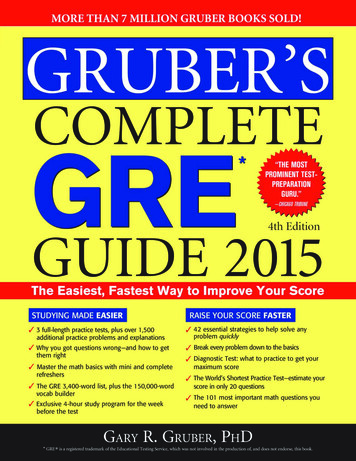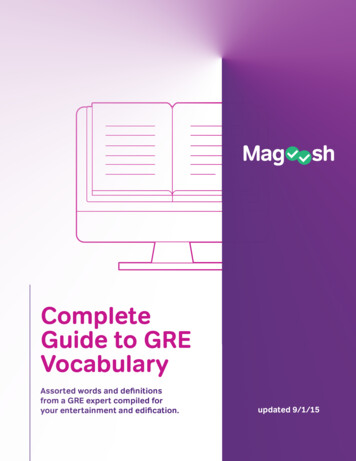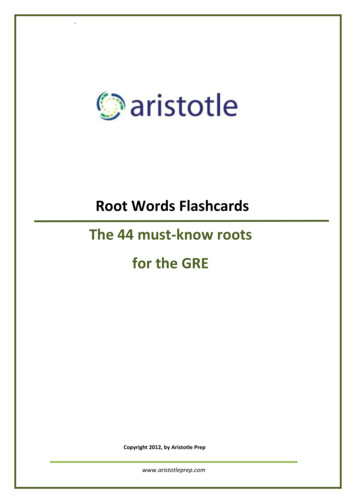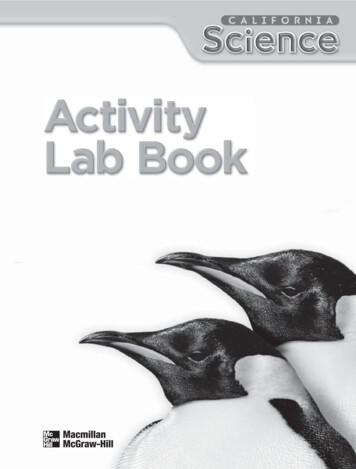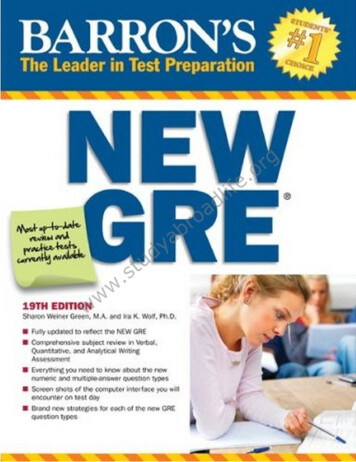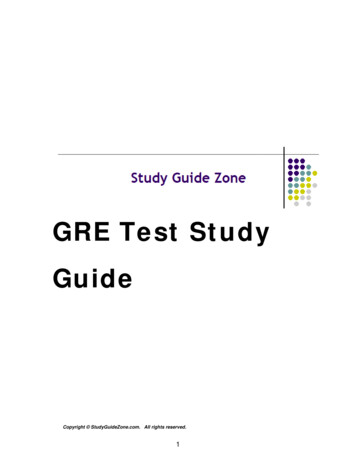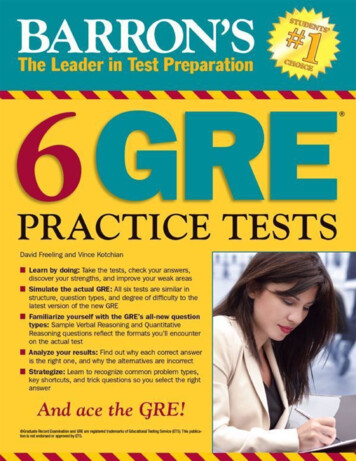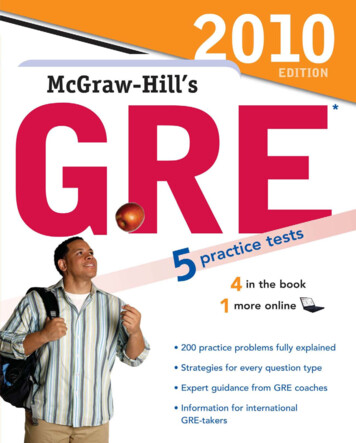
Transcription
50TOP STRATEGIESFOR TEST DAYWhen it’s almost test day, and you’ve readrthis bookand taken the Practice Tests, make sursure you reviewthis page and the pages that follow. HHere you’llfind 50 essential strategies that can definitely helpyou earn more points on the GRE. You’ll see longerexplanations of each strategy, along with examples,in the review portions of this book. The purpose ofthese pages is to provide a handy, all-in-one, lastminute reminder of these valuable concepts. Usethis review to check your test readiness and makesure you’re prepared to do your best—and getyour best score.Guess Carefully6.You have to select an answer before you canmove on, so making high-percentage guessesis important. Eliminate answer choices that youknow are wrong. The more you can eliminate,the better your chance of getting the questionright.COMPUTER-BASED TEST-TAKINGSTRATEGIESMake sure that you practice with released andsimulated exams before you take the actual GRE.GENERAL TEST-TAKINGSTRATEGIESHere are some useful tips to help you maximizeyour GRE score on test day.The Computer System7.Take advantage of the computer tutorial thatis offered before you begin the actual test. Atany point during the test, you may return tothe tutorial by clicking your mouse on the HELPbox at the bottom of the screen.8.Be aware of scroll bars. Some images and textare too big to fit on your screen and requireyou to scroll down to view them.Relax1.Don’t panic if you are having a hard timeanswering the questions! You do not have toanswer all the questions correctly to get a goodscore.2.Take a few moments to relax if you get stressedduring the test. When you get back to the test,you will feel better.Be Aware of Time3.4.5.Pace yourself. Budget enough time for eachquestion so that you won’t have to rush at theend of the section.You cannot go back and change your answers,so read each question carefully to determineexactly what is being asked. Taking the timeto answer one question correctly is betterthan rushing and answering several questionsincorrectly.Stay focused. Ignore the things going onaround you that you cannot control.Adaptive Questions9.The questions for the Verbal and Quantitativesections are adaptive. The computer picksyour question based on your response to theprevious question and the specific test.10. Do not waste time trying to figure out whetheryou answered the previous question correctlyor incorrectly. Just keep working through thetest.11. The only way to move on to another question isto answer the question already on your screen.If you do not know how to answer, make yourbest educated guess and move on.
CRITICAL READINGAnalogiesGRE Critical Reading includes ReadingComprehension passages and questions, SentenceCompletion questions, Analogy questions,Antonym questions, Text Completion questions,and Analytical Writing essay tasks. Following arespecific strategies for each section.21. Before you look at the answer choices, try toReading Comprehension12. Read the questions first and make a mentalnote when the questions refer to specificlines, words, or highlighted text. Do not try tomemorize—just get an idea of what you shouldbe looking for.13. Read each passage for topic, scope, andpurpose. Then skim for structure. Try toisolate one topic word or sentence for eachparagraph. The details will still be there whenyou need them. Don’t spend precious timetrying to “learn” them.14. Try to distinguish between details that arefactual and details that are the opinions of theauthor.15. Try to predict an answer before looking at theanswer choices. If an answer choice matchesyour predicted answer, it is most likely correct.16. Paraphrase when you need to. Putting thequestion and answer choices in your own wordsoften makes them easier to understand.figure out the relationship between the twowords that are given in the question. Use thetwo words in a sentence; substitute the answerchoices into the same sentence.22. There are many different possible relationships,and some are very obscure. Be as specific asyou can when determining the relationshipbetween the original pair of words.23. Always consider ALL the answer choices beforeyou select an answer.Antonyms24. Before you look at the answer choices, try toclearly define the given word. Remember thatyou are looking for the answer choice thathas a meaning OPPOSITE to that of the givenword.25. Consider slight variations in the meaning ofeach word.26. Use the Latin roots, prefixes, and suffixes tofigure out what difficult words mean. Look for“cognates” from French, Spanish, or Italian ifyou recognize them.27. Always consider ALL the answer choices beforeyou select an answer.Text CompletionsSentence Completions17. Use the Latin roots, prefixes, and suffixes tofigure out what difficult words mean. Look for“cognates” from French, Spanish, or Italian ifyou recognize them.18. Let the context of the sentence guide you.Try to look for “clue” words and phrases inthe sentence that might suggest a contrast orcomparison.28. Read through the text once to get an idea ofcontext.29. Pay attention to “clue” words in the text, suchas transition words, that will help you to identifythe structure of the text.30. Start with the blank that seems the most simpleto fill, and then work on the others.31. Once you’ve made your selections, check thetext for logic and grammar.19. Try filling in the blank(s) with your own wordsbefore you look at the answer choices. If youfind an answer choice that is similar to yours, itis most likely correct.20. When you think that you have the correctanswer, read the entire sentence to yourself,using your choice(s) in the blank(s). If it makessense, then mark your answer on the computerscreen.Analytical WritingIssue Task32. Choose between the two topics and discussthe issue from any perspective. Remember,there is no correct position. Choose theposition that you can most strongly support.
33. No matter which position you take, make sureyou have compelling reasons and examplesto support it. Make sure you consider howsomeone might challenge or question yourposition.25MATH CONCEPTS YOUABSOLUTELY NEED TO KNOW1.The area of a circle is A r 2, where r isthe radius of the circle.2.The circumference of a circle is C 2 r,where r is the radius of the circle. Thecircumference can also be expressed as d,because the diameter is always twice theradius.attention to the structure of the argumentand the statements or claims, assumptions,implications, and supporting evidence given orleft out.3.The area of a rectangle is A lw, where lis the length of the rectangle and w is thewidth of the rectangle.36. Remember, your task is to find flaws in the logic4.34. Do not worry about the number of examplesincluded in your essay or the length of youressay; focus on the quality of your ideas.Argument Task35. Carefully read the given argument. Payof the argument, NOT agree with, disagreewith, prove, or disprove the argument.37. Do not worry about the number of examplesincluded in your essay or the length of youressay; focus on the quality of your critique.MATHEMATICSGRE Quantitative (Math) covers four basic contentareas: arithmetic, algebra, geometry, and dataanalysis. The question types include DiscreteQuantitative questions, Data Interpretationquestions, Quantitative Comparison questions, andNumeric Entry questions. Following are specificstrategies for each question type, as well as a quickreview of general math concepts. Emphasis isplaced on the more important skills, concepts, anddefinitions, as well as on particular concepts thatare often confused or misunderstood.1bh, whereThe area of a triangle is A 2b is the base of the triangle and h is theheight of the triangle.5.The volume of a rectangular prism isV lwh, where l is the length of therectangular prism, w is the width ofthe rectangular prism, and h is height ofthe rectangular prism.6.The volume of a cylinder is V r 2h, wherer is the radius of one of the bases of thecylinder and h is the height of the cylinder.7.The perimeter is the distance around anyobject.8.The Pythagorean theorem states thatc 2 a 2 b 2, where c is the hypotenuse ofthe triangle and a and b are the other twosides of the triangle.9.The following are angle measures and sidelengths for Special Right Triangles:General Math Strategies45 The following strategies can be applied to all theGRE math sections.s 260 2x38. Draw pictures on your scratch paper assxnecessary to help you solve problems.39. Look for a way to reason through the problem.40. When reading word problems, translate theminto mathematical equations. (“Carrie has 3 moreCDs than Amy” is equivalent to C A 3)(continued)45 30 x 330-60-90 Triangles45-45-90 Triangle10. In an equilateral triangle, all three sideshave the same length, and each of theangles equals 60 .(continued)
41. Remember to estimate or “ball-park” answerswhen you can. It is often possible to eliminateall but the correct answer choice without doingany actual math.Discrete Quantitative Questions42. Make sure that you understand whatinformation is given and what question is beingasked. Paraphrase if necessary.43. Many questions will allow you to “reason”your way to an answer by performing only afew or even no calculations. Avoid lengthy andcomplicated calculations when possible.Data Interpretation Questions44. Before answering each question, scan the givendata.45. Many of the questions will allow you toapproximate an answer by making a visualcomparison only. Avoid performing calculationswhen possible.46. Do not base your answer to any question onan assumption or any outside information. Useonly the data given.Quantitative Comparison Questions47. Many comparisons require estimation only.Avoid lengthy and complicated calculationswhen possible.48. If one column is sometimes greater orsometimes less than the other column, then therelationship cannot be determined from theinformation. (Answer choice D means that noone can determine the answer, not just that youcan’t determine the answer.)Numeric Entry Questions49. Read the questions carefully and be sure toprovide the type of answer indicated.50. You will not have any answer choices to guideyou, so check your answer and make sure it islogical based on the information provided inthe question.25MATH CONCEPTS YOUABSOLUTELY NEED TO KNOW11. In an isosceles triangle, two sides have thesame length, and the angles opposite thosesides are congruent.12. The complete arc of a circle measures 360 .13. A straight line measures 180 .14. A prime number is any number that can onlybe divided by itself and 1.15. Squaring a negative number yields a positiveresult.16. To change any fraction to a decimal, dividethe numerator by the denominator.17. If two numbers have one or more divisor incommon, those are the common factors ofthe numbers.18. To calculate the mean, or average, of a list ofvalues, divide the sum of the values by thenumber of values in the list.19. The median is the middle value of a listof numbers that is in either ascending ordescending order.20. The mode is the value that appears thegreatest number of times in a list.21. A ratio expresses a mathematical comparison1 or 1:4between two quantities. 4 22. A proportion is an equation involving two1 x or 1:4 x:8ratios. 48 23. When multiplying exponential expressionswith the same base, add the exponents.24. When dividing exponential expressions withthe same base, subtract the exponents.25. When raising one power to another power,multiply the exponents.
2010EDITIONMcGraw-Hill’sGREGraduate Record Examination General TestSteven W. Dulanand the Faculty of Advantage EducationNew York Chicago San Francisco Lisbon LondonMadrid Mexico City Milan New Delhi San Juan SeoulSingapore Sydney Toronto
Copyright 2009, 2010 by The McGraw-Hill Companies, Inc. All rights reserved. Except as permitted under the United States Copyright Act of 1976, no part of this publication may be reproduced or distributed in any form or by any means, or stored in a database or retrieval system, without the prior written permission of the publisher.ISBN: 978-0-07-162427-5MHID: 0-07-162427-9The material in this eBook also appears in the print version of this title: ISBN: 978-0-07-162426-8, MHID: 0-07-162426-0.All trademarks are trademarks of their respective owners. Rather than put a trademark symbol after every occurrence of a trademarked name, we use names in an editorialfashion only, and to the benefit of the trademark owner, with no intention of infringement of the trademark. Where such designations appear in this book, they have beenprinted with initial caps.McGraw-Hill eBooks are available at special quantity discounts to use as premiums and sales promotions, or for use in corporate training programs. To contact a representative please e-mail us at bulksales@mcgraw-hill.com.GRE is a registered trademark of Educational Testing Service (ETS), which was not involved in the production of, and does not endorse, this product.Product or brand names used in this book may be trade names or trademarks. Where we believe that there may be proprietary claims to such trade names or trademarks, thename has been used with an initial capital or it has been capitalized in the style used by the name claimant. Regardless of the capitalization used, all such names have beenused in an editorial manner without any intent to convey endorsement of or other affiliation with the name claimant. Neither the author nor the publisher intends to expressany judgment as to the validity or legal status of any such proprietary claims.TERMS OF USEThis is a copyrighted work and The McGraw-Hill Companies, Inc. (“McGraw-Hill”) and its licensors reserve all rights in and to the work. Use of this work is subject to theseterms. Except as permitted under the Copyright Act of 1976 and the right to store and retrieve one copy of the work, you may not decompile, disassemble, reverse engineer,reproduce, modify, create derivative works based upon, transmit, distribute, disseminate, sell, publish or sublicense the work or any part of it without McGraw-Hill’s priorconsent. You may use the work for your own noncommercial and personal use; any other use of the work is strictly prohibited. Your right to use the work may be terminatedif you fail to comply with these terms.THE WORK IS PROVIDED “AS IS.” McGRAW-HILL AND ITS LICENSORS MAKE NO GUARANTEES OR WARRANTIES AS TO THE ACCURACY, ADEQUACYOR COMPLETENESS OF OR RESULTS TO BE OBTAINED FROM USING THE WORK, INCLUDING ANY INFORMATION THAT CAN BE ACCESSED THROUGHTHE WORK VIA HYPERLINK OR OTHERWISE, AND EXPRESSLY DISCLAIM ANY WARRANTY, EXPRESS OR IMPLIED, INCLUDING BUT NOT LIMITED TOIMPLIED WARRANTIES OF MERCHANTABILITY OR FITNESS FOR A PARTICULAR PURPOSE. McGraw-Hill and its licensors do not warrant or guarantee that thefunctions contained in the work will meet your requirements or that its operation will be uninterrupted or error free. Neither McGraw-Hill nor its licensors shall be liable toyou or anyone else for any inaccuracy, error or omission, regardless of cause, in the work or for any damages resulting therefrom. McGraw-Hill has no responsibility for thecontent of any information accessed through the work. Under no circumstances shall McGraw-Hill and/or its licensors be liable for any indirect, incidental, special, punitive,consequential or similar damages that result from the use of or inability to use the work, even if any of them has been advised of the possibility of such damages. This limitation of liability shall apply to any claim or cause whatsoever whether such claim or cause arises in contract, tort or otherwise.
About the AuthorSteven W. Dulan, J.D. has been involved with GRE preparation since 1989. Aformer U.S. Army Infantry Sergeant, Steve scored in the 99th percentile on everystandardized test he has ever taken. After graduating from Michigan State, Steveattended The Thomas M. Cooley Law School on a full Honors Scholarship. Whileattending law school, Steve continued to teach standardized test prep classes(including ACT, SAT, PSAT, GRE, GMAT, and LSAT) an average of 30 hours eachweek, and tutored some of his fellow law students in a variety of subjects and inessay exam writing techniques. Professor Dulan has also served as an instructorat Baker University, Cleary University, Lansing Community College, The OhioState University-Real Estate Institute, and The Thomas M. Cooley Law School.Guest lecturer credits include Michigan State University, University of Michigan,Detroit College of Law, Marquette University, Texas Technical University,University of Miami, and Wright State University.Thousands of students have benefited from Steve’s instruction, coaching,and admissions consulting, and have entered the graduate programs of theirchoice. Steve’s students have gained admission to some of the most prestigiousinstitutions of higher learning in the world, and have received numerousscholarships and fellowships of their own. Since 1997, Steve has served asthe president of Advantage Education (www.AdvantageEd.com), a companydedicated to providing effective and affordable test prep education in a varietyof settings, including one-on-one tutoring via the Internet worldwide using itsPersonal Distance Learning system. The information and techniques included inthis book are the result of Steve’s experiences with test preparation students at alllevels over many years.iii
AcknowledgmentsI would like to acknowledge the outstanding contribution of the faculty andstaff of Advantage Education. Your hard work and dedication have made thisendeavor a success. You are not only the smartest but also the best.The following Advantage Education staff members deserve special thanks fortheir extra efforts:Senior Editor and Project Manager: Amy DulanContributing Authors/Editors: Pamela Chamberlain, Lisa DiLiberti,Megan Hettwer, Matt Mathison, Blair Morley, Ryan Particka,Jordan Pearce, Andrew Sanford, and Amanda Thompson.iv
Contents at a GlancePART I: Introduction to the GRE General TestCHAPTER 1CHAPTER 2CHAPTER 3Overview of the GRETaking the GREInformation for International Test-Takers31115PART II: Preparing for the GRE General TestCHAPTER 4CHAPTER 5CHAPTER 6CHAPTER 7CHAPTER 8CHAPTER 9GRE Diagnostic TestGRE General Testing StrategiesIntroduction to GRE LogicGRE Analytical Writing AssessmentGRE QuantitativeGRE Verbal21617185115141PART III: Content Area ReviewCHAPTER 10 Basic GRE Math ReviewCHAPTER 11 Basic GRE Verbal Review191247PART IV: Practicing for the GRE General TestCHAPTER 12 GRE Practice Test 1CHAPTER 13 GRE Practice Test 2CHAPTER 14 GRE Practice Test 3271315361AppendixesAPPENDIX A GRE Vocabulary ListAPPENDIX B Glossary of GRE Math TermsAPPENDIX C Additional Resources407439451
ContentsHow to Use This BookHow to Use the Practice TestsGRE Training ScheduleA Note on Scoring the Practice TestsWhat’s Next?xvxvxvixviixviiiPart I: Introduction to the GRE General TestCHAPTER 1 Overview of the GREGRE FormatGRE Question TypesAnalytical WritingVerbalQuantitativeMore on the Computer Adaptive Test (CAT)What’s Next?3455681010CHAPTER 2 Taking the GRERegistering for the GRE General TestTaking the GRE General TestScoring the GRE General TestScoring the General Test Analytical Writing SectionScoring the General Test Verbal and Quantitative SectionsA Note on Scoring the Practice Exams in this BookWhat Your Scores Mean to SchoolsTest-Takers with DisabilitiesWhat’s Next?11CHAPTER 3 Information for International Test-TakersThe Language BarrierThe Registration ProcessThe Day of the TestThe Student VisaVisa RequirementsWhat’s Next?15111212131313141414161617171818
Part II: Preparing for the GRE General TestCHAPTER 4 GRE Diagnostic TestSection 1—Issue TaskSection 2—Argument TaskSection 3—VerbalSection 4—QuantitativeGRE Diagnostic Test Answer KeyScoring GuidelinesGRE Diagnostic Test Answers and ExplanationsSections 1 and 2—Analytical WritingSection 3—VerbalSection 4—Quantitative21CHAPTER 5 GRE General Testing StrategiesKnowledge, Skills, and Abilities (KSA)Focus on the Easy StuffStay “On Point”SimplifyGuess WiselyManage StressRelax to SucceedSpecific Relaxation TechniquesBe PreparedKnow YourselfRestEat RightBreatheTake Mental BreaksHave a Plan of AttackBe Aware of TimeListen to MusicSome CAT StrategiesWhat to Expect on Test DayTake a Dry RunWake Up EarlyDress for SuccessFuel UpBring SuppliesWarm Up Your BrainPlan a Mini-VacationWhat’s 7676767686868696969696969707070vii
CHAPTER 6 Introduction to GRE LogicArgumentsContextChain of ReasoningAssumptionsValidity, Truth, and allaciesSlippery SlopePercent versus NumberSampling ErrorCorrelation versus CausationEquivocationAd Hominem ArgumentsAppeal to AuthorityAppeal to Majority: The Quantity/Quality FallacyCircular ArgumentBegging the QuestionReductio Ad AbsurdumWhat’s Next?71CHAPTER 7 GRE Analytical Writing AssessmentBreaking Down the Analytical Writing AssessmentScoring the Analytical Writing SectionsWhat the GRE Readers Are Looking ForWriting TechniquesWriting StrategiesClearly State Your PositionPresent Your Ideas LogicallyReview and Correct Your EssayIssue TaskThe Time LimitThe IssuesYour ResponseSample Essay Prompt 1: Present Your Perspective on an IssueSample Essay Prompt 2: Present Your Perspective on an IssueArgument TaskThe Time LimitThe ArgumentYour ResponseSample Essay Prompt 1: Analyze an 4
Sample Essay Prompt 2: Analyze an ArgumentPractice Writing PromptsIssue Task PracticeArgument Task PracticeWhat’s Next?108112112112113CHAPTER 8 GRE QuantitativeDiscrete Problem Solving QuestionsAnatomy of a GRE Discrete Problem Solving QuestionGeneral Strategies for Discrete Problem Solving QuestionsDiscrete Problem Solving Multiple-Choice Practice QuestionsAnswers and ExplanationsQuantitative Comparison QuestionsAnatomy of a GRE Quantitative Comparison QuestionGeneral Strategies for Quantitative Comparison QuestionsQuantitative Comparison Practice QuestionsAnswers and ExplanationsNumeric Entry QuestionsAnatomy of a GRE Numeric Entry QuestionGeneral Strategies for Numeric Entry QuestionsNumeric Entry Practice QuestionsAnswers and ExplanationsWhat’s Next?115CHAPTER 9 GRE VerbalAntonym QuestionsAnatomy of a GRE Antonym QuestionGeneral Strategies for Antonym QuestionsPractice Antonym QuestionsAnswers and ExplanationsAnalogy QuestionsAnatomy of a GRE Analogy QuestionGeneral Strategies for Analogy use and EffectPractice Analogy QuestionsAnswers and ExplanationsSentence Completion QuestionsAnatomy of a GRE Sentence Completion QuestionGeneral Strategies for Sentence Completion 54155156159160161161ix
Understand the ContextPractice Sentence Completion QuestionsAnswers and ExplanationsReading Comprehension QuestionsAnatomy of a GRE Reading Comprehension QuestionGeneral Strategies for Reading Comprehension QuestionsReading Comprehension Question TypesPractice Reading Comprehension QuestionsAnswers and ExplanationsAnswers and ExplanationsText Completion with Two or Three Blank QuestionsAnatomy of a GRE Text Completion QuestionGeneral Strategies for Text Completion QuestionsPractice Text Completion QuestionsAnswers and ExplanationsWhat’s 187Part III: Content Area ReviewCHAPTER 10 Basic GRE Math ReviewNumbers and OperationsThe Properties of IntegersReal NumbersOrder of Operations (PEMDAS)DecimalsFractions and Rational NumbersSquares and Square RootsExponentsScientific NotationMean, Median, and ModeRatio, Proportion, and PercentAbsolute ValueSimple Probability and OutcomesFactors and MultiplesExercises: Numbers and OperationsBasic OperationsSquares and Square RootsExponentsScientific NotationMean, Median, and ModeRatio, Proportion, and PercentAbsolute ValueSimple Probability and OutcomesFactors and 99199200200201202202202203203204204
Answers and ExplanationsBasic OperationsSquares and Square RootsExponentsScientific NotationMean, Median, and ModeRatio, Proportion, and PercentAbsolute ValueSimple Probability and OutcomesFactors and MultiplesAlgebra and FunctionsLinear Equations with One VariablePolynomial Operations and Factoring Simple Quadratic ExpressionsSystems of EquationsInequalitiesFunctionsExercises: Algebra and FunctionsLinear Equations with One VariablePolynomial Operations and Factoring Simple Quadratic EquationsSystems of EquationsLinear Inequalities with One VariableFunctionsAnswers and ExplanationsLinear Equations with One VariablePolynomial Operations and Factoring Simple Quadratic EquationsSystems of EquationsLinear Inequalities with One VariableFunctionsGeometryCoordinate GeometryTrianglesQuadrilaterals, Lines, AnglesSome Other PolygonsCirclesThree-Dimensional FiguresExercises: GeometryCoordinate GeometryProperties and Relations of Plane FiguresAngles, Parallel Lines, and Perpendicular LinesPerimeter, Area, and VolumeAnswers and ExplanationsCoordinate GeometryProperties and Relations of Plane FiguresAngles, Parallel Lines, and Perpendicular LinesPerimeter, Area, and 27229230230231231232232234234234236238238xi
Word Problems and Data AnalysisWord ProblemsData AnalysisExercises: Word Problems and Data AnalysisTranslating Word ProblemsData AnalysisAnswers and ExplanationsWord ProblemsData AnalysisWhat’s Next?CHAPTER 11 Basic GRE Verbal ReviewGrammar RulesSubject/Verb AgreementNouns and PronounsVerbs and Verb FormsSentence ConstructionPunctuation RulesCommasApostrophesColons and SemicolonsParentheses and DashesEnd PunctuationRhetoricCommonly Misused WordsWhat’s 252255255257258260260261261267Part IV: Practicing for the GRE General TestxiiCHAPTER 12 GRE Practice Test 1Section 1—Issue TaskSection 2—Argument TaskSection 3—VerbalSection 4—QuantitativeGRE Practice Test 1 Answer KeyScoring GuidelinesGRE Practice Test 1 Answers and ExplanationsSections 1 and 2—Analytical WritingSection 3—VerbalSection 4—Quantitative271CHAPTER 13 GRE Practice Test 2Section 1—Issue TaskSection 2—Argument TaskSection 24
Section 4—QuantitativeGRE Practice Test 2 Answer KeyScoring GuidelinesGRE Practice Test 2 Answers and ExplanationsSections 1 and 2—Analytical WritingSection 3—VerbalSection 4—Quantitative336345346348348348352CHAPTER 14 GRE Practice Test 3Section 1—Issue TaskSection 2—Argument TaskSection 3—VerbalSection 4—QuantitativeGRE Practice Test 3 Answer KeyScoring GuidelinesGRE Practice Test 3 Answers and ExplanationsSections 1 and 2—Analytical WritingSection 3—VerbalSection ppendixesAPPENDIX A GRE Vocabulary ListAPPENDIX B Glossary of GRE Math TermsAPPENDIX C Additional Resources407439451xiii
This page intentionally left blank
How to Use This BookThis book includes general information about the GREGeneral Test and chapters with specific information oneach of the test sections, as well as additional simulatedpractice tests. In an ideal situation, you will be readingthis book at least three to four weeks before you take theactual GRE General Test. In our experience, the studentswho see the largest increases in their scores are those whoput in consistent effort over several weeks. Try to keep yourfrustration to a minimum if you are struggling. In addition,try to keep from becoming overconfident when everything isgoing your way. The GRE Training Schedule shown on thenext page will help you to manage your time effectively andstay focused during your preparation.GRE TipIf you have already registeredfor a specific test date but donot feel that you are ready forthe test, it might be better toreschedule your GRE. Theremay be additional fees, butyou will have a more positivetesting experience andachieve your maximum score ifyou are sufficiently prepared.How to Use the Practice TestsThe practice tests found in this book are reasonably accurate simulations writtenby GRE experts. They contain basically the same mix of question types as a realGRE. If you work through all the material provided, you can rest assure that therewon’t be any surprises on test day.The biggest difference between the practice tests in this book and your realGRE is the fact that these are not computer adaptive tests (see Chapter 1 for moreinformation on the CAT format). You should use these practice tests to becomefamiliar with the different question types and reveal any gaps in your knowledge.Generally, students tend to score a little better on each successive practice test.Keep in mind that GRE test results are sensitive to individual conditionssuch as fatigue and stress. Therefore, the time of day that you take your practicetests, your environment, and other things that might be going on in your lifecan have an impact on your scores. Don’t get worried if you see some scorefluctuation because of a bad day or because the practice tests indicate weaknessesin your knowledge or skills. Simply use this information to help you improve.Plan to do some practicing with POWERPREP , the free software from the authorsof the GRE that is made available at www.gre.org, to get a good feel for how thequestions will be presented on test day.xv
GRE TRAINING SCHEDULEAt least 4 weeks before your GRETake the Diagnostic Test (Chapter 4) under realistic conditions. Time yourself strictly. Take the test in a placethat approximates actual test conditions, such as a library. Evaluate your results and pinpoint your areas ofstrength and weakness. Rea
your GRE score on test day. Relax 1. Don’t panic if you are having a hard time answering the questions! You do not have to answer all the questions correctly to get a good score. 2. Take a few moments to relax if you get stressed during the test. When you get back to the test,
